

A Little Weird? Prone to Depression? Blame Your Creative Brain. Whenever you want to do something extraordinary, risky, or scary in your life (something that you know in your heart that you need to do, but it would really be more convenient to ignore it and just not do it), it’s essential to surround yourself with inspiring, encouraging, like-minded people. If they’re leaders in their own right who to a certain degree have done what you long to do, even better. I first met Gwyneth Leech last summer at my nephew’s first birthday party in Brooklyn (she’s my sister’s husband’s cousin).
We were chatting idly until the moment she mentioned that she, a lifelong artist, had “accidentally” started creating art on used coffee cups, drawing to pass time in PTA meetings. I get as excited about a great story as some women get about shoes, and my story sensors started shrieking immediately. Gwyneth has become a close friend and a beacon of inspiration and encouragement in my life as I contemplate great leaps of faith and creation. Can you relate to this? How Creativity Connects with Immorality.
In the mid 1990’s, Apple Computers was a dying company.
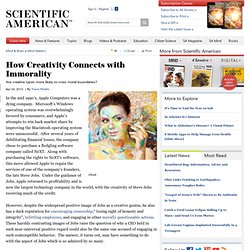
Microsoft’s Windows operating system was overwhelmingly favored by consumers, and Apple’s attempts to win back market share by improving the Macintosh operating system were unsuccessful. After several years of debilitating financial losses, the company chose to purchase a fledgling software company called NeXT. Along with purchasing the rights to NeXT’s software, this move allowed Apple to regain the services of one of the company’s founders, the late Steve Jobs. Under the guidance of Jobs, Apple returned to profitability and is now the largest technology company in the world, with the creativity of Steve Jobs receiving much of the credit.
How to be creative. Abstraction. Abstraction is a process by which concepts are derived from the usage and classification of literal ("real" or "concrete") concepts, first principles, or other methods.

"An abstraction" is the product of this process—a concept that acts as a super-categorical noun for all subordinate concepts, and connects any related concepts as a group, field, or category.[1] Abstractions may be formed by reducing the information content of a concept or an observable phenomenon, typically to retain only information which is relevant for a particular purpose. For example, abstracting a leather soccer ball to the more general idea of a ball retains only the information on general ball attributes and behavior, eliminating the other characteristics of that particular ball.[1] Origins[edit] Thinking in abstractions is considered[by whom?]
Abstraction involves induction of ideas or the synthesis of particular facts into one general theory about something. Thought process[edit] Cat on Mat (picture 1) Creativity. Creativity is a phenomenon whereby something new and somehow valuable is formed, such as an idea, a scientific theory, an invention, a literary work, a painting, a musical composition, a joke, etc.
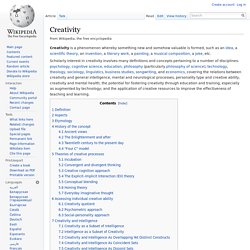
Scholarly interest in creativity involves many definitions and concepts pertaining to a number of disciplines: psychology, cognitive science, education, philosophy (particularly philosophy of science), technology, theology, sociology, linguistics, business studies, songwriting, and economics, covering the relations between creativity and general intelligence, mental and neurological processes, personality type and creative ability, creativity and mental health; the potential for fostering creativity through education and training, especially as augmented by technology; and the application of creative resources to improve the effectiveness of teaching and learning. Definition[edit] Creative problem solving. Creative problem-solving, a type of problem solving, is the mental process of searching for a new and novel creative solution to a problem, a solution which is novel, original and not obvious.
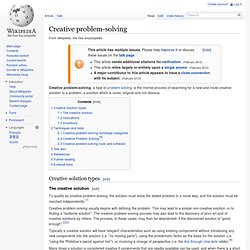
Creative solution types[edit] The creative solution[edit] To qualify as creative problem-solving, the solution must solve the stated problem in a novel way, and the solution must be reached independently.[1] Creative problem-solving usually begins with defining the problem. This may lead to a simple non-creative solution, or to finding a "textbook solution".
Typically a creative solution will have 'elegant' characteristics such as using existing components without introducing any new components into the solution (i.e. Convergent and divergent production. Convergent and divergent production are the two types of human response to a set problem that were identified by J.P.

Guilford (1967). Guilford observed that most individuals display a preference for either convergent or divergent thinking. Others observe that most people prefer a convergent closure. Divergent thinking. Don't Shut Down Other Lines of Thought. Creativity Rocks! There are few things that are more satisfying than coming up with a creative solution to a vexing problem.

In fact, the feeling you get from finding a clever way out of a mess, of seeing old things in a new ways, or of making something from nothing can be wonderfully addictive. Unfortunatley, most people aren't encouraged to be creative in their everyday lives. They are given very specific instructions about what to do, whether in school or at work, and are measured by how accurately they replicate what others have done. This is a huge missed opportunity all the way around. Below are some of my favorite video clips of thought leaders talking about the value of creative problem solving. Tom Kelley of IDEO talks about the habits you can adopt to make yourself more creative: Is Your Idea Crazy Enough? Stupidity Rules for Creative Professionals. I'm having trouble being stupid.

Productively stupid, that is. I have infinite reserves of unproductive stupidity—ignoring my car's oil light, losing my wallet, hiring the wrong person. That's the variety of a presidential candidate forgetting during a national debate which federal agencies he wants to eliminate ("Oops"). Productive stupidity is something else.
But I'm getting ahead of myself with that know-it-all assertion. Twelve Things You Were Not Taught in School About Creative Thinking. Myths of Right-Brained Creativity. "I'm not creative.
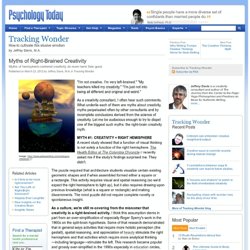
I'm very left-brained. " "My teachers killed my creativity . " "I'm just not into being all different and original and weird. " As a creativity consultant, I often hear such comments. What underlie each of them are myths about creativity, myths perpetuated often by other consultants and by incomplete conclusions derived from the science of creativity. {*style:<b>MYTH #1: CREATIVITY = RIGHT HEMISPHERE. Alcohol Benefits the Creative Process. Creative thought is something we often aspire to.

WHERE GOOD IDEAS COME FROM by Steven Johnson. A Computer-Model for the Creative Process Beyond Simple Brainstorming « Visualizing the Invisible. To build computer systems which particularly support creativity, an abstract process model is necessary.
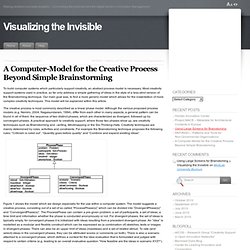
Most creativity support systems used in practice, so far only address a simple gathering of ideas in the style of a less-strict version of the Brainstorming-technique. Our main goal was, to find a more generic model which allows for the instantiation of more complex creativity techniques. Making Good Lessons Great: Incorporating Multiple Iintelligences and Creative Thinking into Everyday Lesson Plans « clearings. By Betty K. Wood and Andrew L.
Hunt, University of Arkansas at Little Rock Sarah C. Wood-Jenkins, Ball State University I didn’t find anything very revolutionary here except this quote which I shall bear in mind (lay-out is mine): ‘One model for teaching the skill of creative thinking involves: fluency flexibility originalityelaboration‘ Deadlines : Creativity and Time. Five glorious presentations on visual thinking. Do you think in words or pictures, or both? Visual thinking engages the part of the brain that handles visual processing, and is said to be both "emotional and creative" so you can "organise information in an intuitive and simultaneous way". A picture really might be worth a thousand words, while being easier to understand and recall. Therefore it is worth exploring how visual thinking can help you communicate ideas to colleagues and clients.
I have collated a few presentations to help you do exactly that. How Geniuses Think. If You Are Creative, Are You Also Intelligent? According to an article in Newsweek , here in the United States we apparently have a creativity crisis . According to Kyung Hee Kim at the College of William and Mary, scores on the Torrance Test of Creative Thinking have been decreasing since the 1990's. The same article mentions that China is making a push to move away from rote memorization and adopt a more problem centered learning approach, perhaps like that of America. Contrast this with the results from the Program for International Student Assessment (PISA), which examines 15-year-old students in 65 countries. Mad Genius, Eccentric Behavior & Creative Process. Kristi Tencarre : Mad Genius Eccentric Creative Beings By Kristi Tencarre What is madness, except for non-conformity to the norm?
Majority makes up the norm, therefore their definition of madness becomes the marker signaling the labeled to watch out for and stay away from. Madness has been officially defined as mentally unstable. Creative thinking with creative geniuses like you! A Creative Buzz - Ideas Market. By Christopher Shea. The Inspiration Paradox: Your Best Creative Time Is Not When You Think. Thinking skills. There is no logic in connecting an office copier with 'nose'. That is to say, there is no 'logic' in our normal undertanding of logic. This understanding is based on passive surface information systems. List of creative thought processes. The following outline is provided as an overview of and topical guide to thinking:
Creative thought. The Creative Thought Process - Part One. One of the big parts of being an Event Designer is the creation of an event. By this I mean the ability to take what your client says to you and translate that into something amazing, dazzling, inspiring and ultimately something that represents what your client had in mind. I say that with tongue in cheek as most of our clients don’t actually know what they want and that is where you come in.